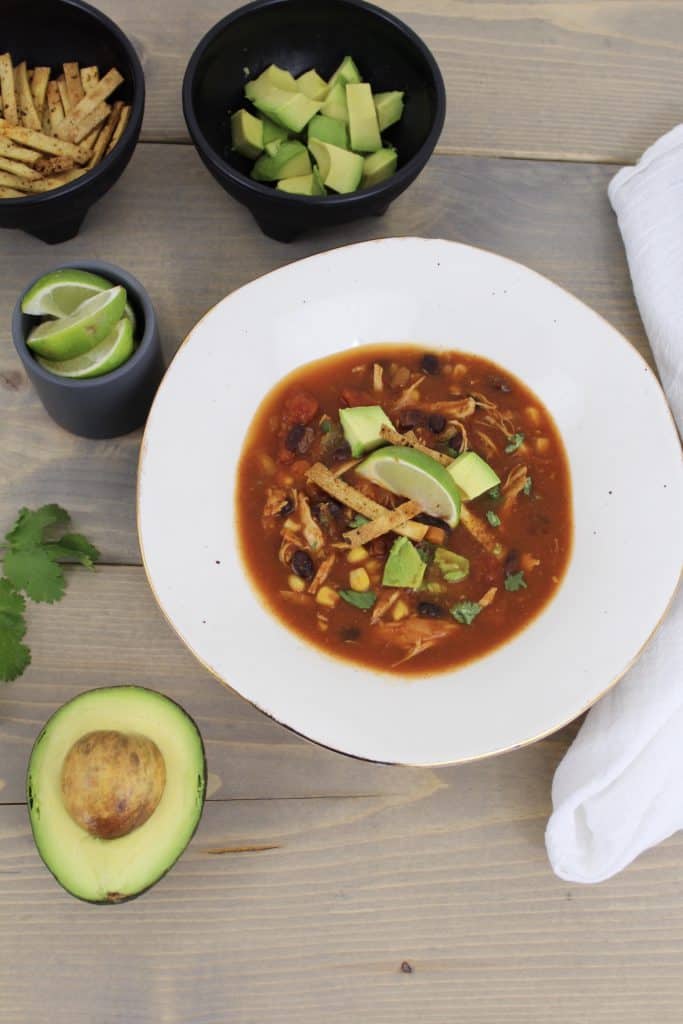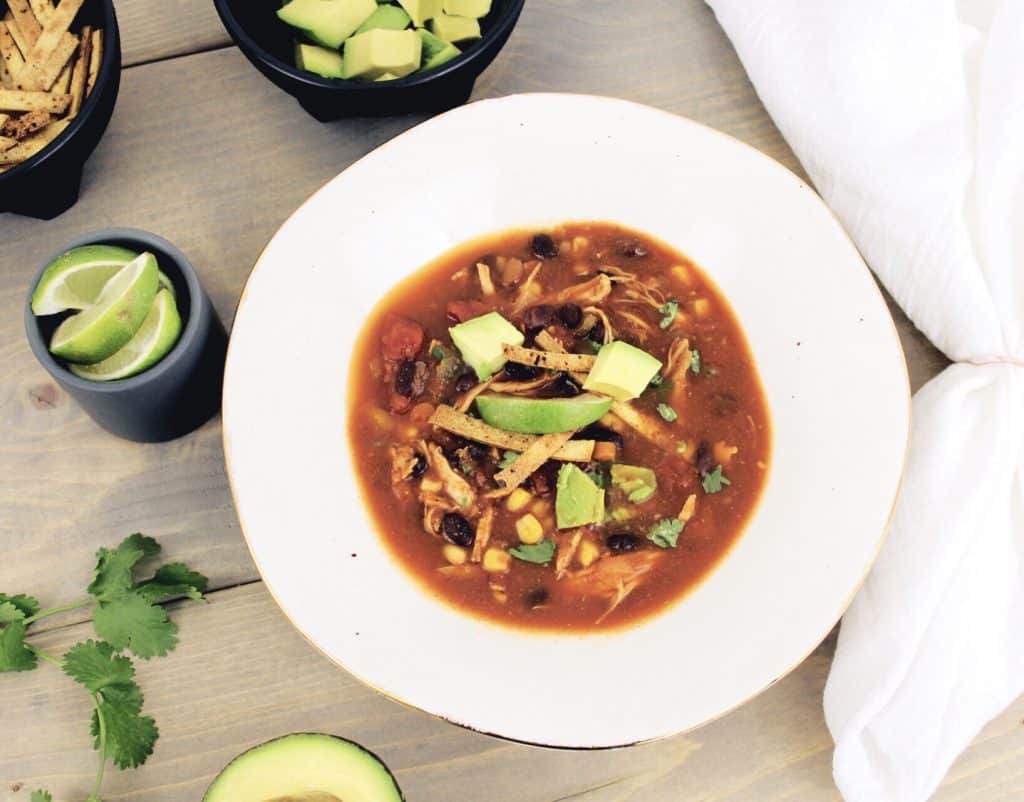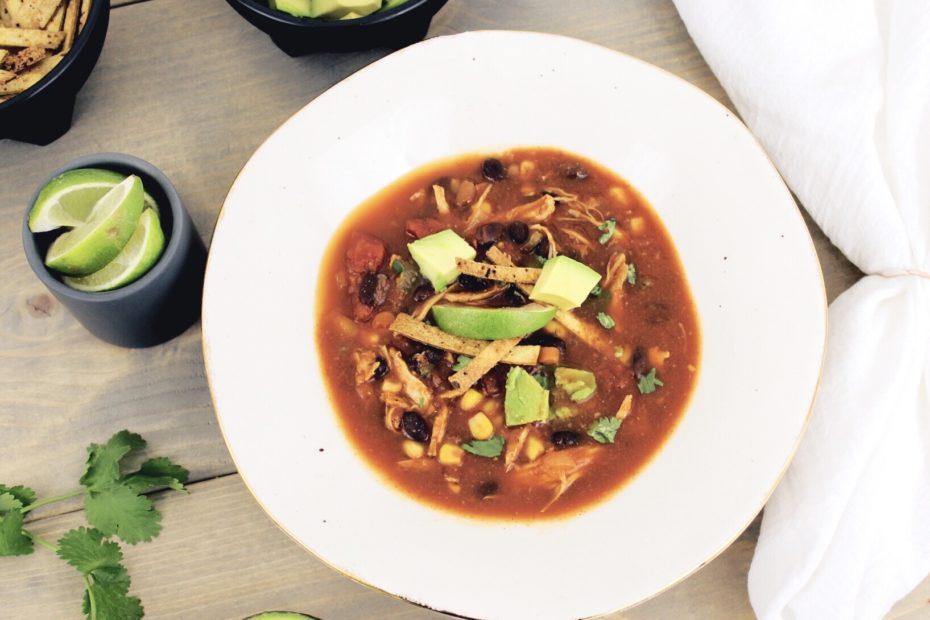Who here is a winter person? Winter is my least favorite season (in New Jersey)!
I am always cold, the shorter days are depressing, I have to wear more clothes, and did I mention I don’t like the cold? Moving would be the only option, but not an option at this point. We enjoy having our family less than 10 minutes away, we love the friends we have, my husband’s job here, and many more reasons. So instead, we have to find ways to keep us warm.
Here comes soup, warm drinks, sweaters, heated seats, very heated house, and blankets.
January is also the time people want to eat healthier, right in the middle of comfort food season and soup season.
Ahh, so picture it.. You picked out your favorite green sweater to wear for work-from-home, jeans (we all know we need to wear them once in awhile), and your fuzzy socks from your Christmas stocking. So cozy! You open the door to feel how crisp the air is and you get hit with cold burst of air, making you cold again.
‘Ding ding’, the coffee pot is done brewing your coffee, just in time to get warm again! Instead of your usual frozen fruit and veggie protein smoothie, you decide to make a warm breakfast since the smoothie is just going to make you all chilly inside. Oatmeal it is! You are eating healthy, so oatmeal is a great option. Since the ready to make packets are filled with unnecessary items and more sugar than needed, you make your own concoction. Making your own, you have better control of what goes into it. Your favorite is the brown sugar oatmeal, so you decide to add 1 tsp of brown sugar, walnuts (for extra healthy fats and protein), 1/2 cup quick oats (high in fiber), milk (added protein depending on what kind), chia and flax seeds (healthy fats). Once the oatmeal is just the right consistency, per goldilocks (haha), you top with some fresh berries.
With coffee in hand and oatmeal in bowl, you relax at your kitchen table. With each bite, you feel the warmth of the oatmeal in your mouth, down your esophagus, into your stomach churning as it breaks down, through your small intestines, then big intestines, rectum, finish in the anus, and you will see the end results. Ok so maybe you don’t feel it the whole time as it digests and really just feel the warmth in your mouth. Maybe you really don’t think about the process of digestion (or care) and it takes a few hours for digestion, especially when you have healthy fats and fiber that you are digesting.
From your warm clothing to warm breakfast you get your work day started. If you got a workout completed already than dang you are really warmed up, but maybe you do that at lunch break or after work. Sitting at your desk ready to work, you feel satisfied with the healthy and filling breakfast that also helps you focus (walnuts, chia, and flax are rich in omega 3 FA which help with brain health). You find that after sitting for too long and drinking ice cold water you start getting cold, so you get up, go to the bathroom, do a few squats, jumping jacks, and push ups. Warmed up again!
Wow 4 hours went quick and it is time for lunch and a break from the screens! You fill up on leftovers from the night before and more water. Since you are home, you have the luxury of getting dinner started in the crock pot! Soup sounds good on this cold day but also want some kind of Southwest flavors. Good thing you came to this blog, I have the perfect, healthy recipe to give you a bite of Southwest/Tex-Mex in each bite: corn, beans, tomato, and chili powder.
What a relief to have dinner prepared and completed by the time you are done work. Because who really wants to figure out dinner 1 hr before it is time to eat? NOT ME! The other benefit of this dinner, is enough to freeze or eat for lunch the next day (depending on how many people you are feeding and how hungry they are).
So enjoy this dinner and maybe think about digestion. Actually let’s talk about digestion! Digestion was also fascinating for me and a reason I became a dietitian. I love learning how our bodies work. So I went through my old school books to teach you about digestion!
Digestion 101:
Digestion is the breakdown of your food. It is complex but goes through your system starting with your mouth and the enzymes in saliva breaking down mostly starches into a ball of food called a bolus to the pharynx in the back of your mouth that sends the bolus to the esophagus. The esophagus moves food with a wavelike movement called peristalsis to pass through the gastroesophageal sphincter, which opens to allow food to go into the stomach but closes off to prevent food from going back into the esophagus.
The stomach is in a j-shape and includes the fundus, body, and antrum. Your stomach temporary stores food, can expand due to it’s accordion-like lining (called rugae) to hold up to 1-2 quarts and when small can go to 1/4 cup (this triggers a neural response to signal your brain your full), produces gastric secretions for digestion, mixes the food with gastric juices (contains water, hydrochloric acid, mucus, and intrinsic factor and absorbs: water, ethyl alcohol, copper, iodide, fluoride, and molybdenum. The once food bolus now becomes chyme and is now more like a paste, since it is digested much more! The chyme leaves the stomach by the pyloric sphincter into the duodenum.
The duodenum, jejunum, and ileum make up the small intestines, which most nutrient absorption occurs. The small intestines’ lining is filled with villi that help nutrition digestion and absorption (gets damaged if celiac disease isn’t taken care of). The hormones cholecystokinin (CCK) and secretin helps to stimulate the pancreas to release pancreatic juices to neutralize the chyme and gallbladder to release bile to help in digestion of fatty foods. The nutrients absorbed in the duodenum and jejunum include: calcium, phosphorus, magnesium, iron, copper, selenium, thiamin, riboflavin, niacin, biotin, folate, vitamins A, D, E, K, C, B6, zinc, chromium, manganese, molydenum, pantothenate, lipids, monosaccharides, amino acids, small peptides. The ileum absorbs: folate, magnesium, vit D, B12, K, bile salts and acids. The nutrients absorbed are sent through the body through the veins, arteries, and lymphatic vessel to the liver and throughout the body.
The foods that aren’t digested go to the last part of digestion through the ileocecal sphincter to the large intestines. The large intestines consists of the cecum, colon, rectum, and anal canal. The large intestine absorbs water, vit K, biotin, sodium, chloride, potassium, and short chain fatty acids. Most bacteria in GI tract are contained here, called microbiota. The bacteria are important to breakdown the undigested and fibrous foods, produce vitamin K and B12, and some lipids. The waste is held in the rectum until eliminated through the relaxed anal sphincter to the anus and out of the body.
This is just touch points and can get even deeper into digestion, which is why it is digestion 101!
So next time you eat, maybe you think about the job your body does to eliminate all that food!
Source: Nutritional Sciences: from Fundamentals to Food Table of Food Composition Booklet 2nd (second) edition by Mcguire, Michelle, Beerman, Kathy A. published by Brooks/Cole Pub Co (2009) [Paperback]
Chicken Tortilla Soup
Course: Dinner, SoupCuisine: Mexican, SouthwestDifficulty: Easy5
servings20
minutes1
hourThis healthy soup provides a ton of veggies, beans, and spices that bring the Southwest flavors into each bite!
Ingredients
2 chicken breasts
1/4 cup low sodium broth
1 can (15oz) black beans, rinsed and drained
1 can (15oz) tomato sauce
1 can (15oz) diced tomatoes low salt
1/2 onion, chopped
2 garlic cloves, chopped
1 celery stalk, chopped
1 carrot stick, chopped
1/2 fresh lime juice
2 cups low sodium broth
1 tbsp chili powder
2 tsp cumin
1 tsp paprika
1/4 tsp cayenne pepper
Topping: chili lime tortilla strips, avocado, cilantro, lime
Directions
- In a slow cooker or pressure cooker, first cook chicken with 1/4 cup broth for 10 minutes.
- Add remaining ingredients (except toppings).
- Pressure cook at high for 10 minutes OR slow cook for 3 hours.
- Remove chicken, shred with two forks and add back into the soup.
- Slow cook the soup until ready to serve. The longer it sits, the better.
- To make homemade tortilla strips: preheat oven to 350℉, slice tortillas thinly, add to pan, spray with oil, sprinkle with chili lime seasoning (From TJ), bake for 20 minutes.
- Top soup with homemade tortilla strips, avocado, cilantro, lime, and whatever else you fancy.
- Disfrutar! (Enjoy in Spanish)




